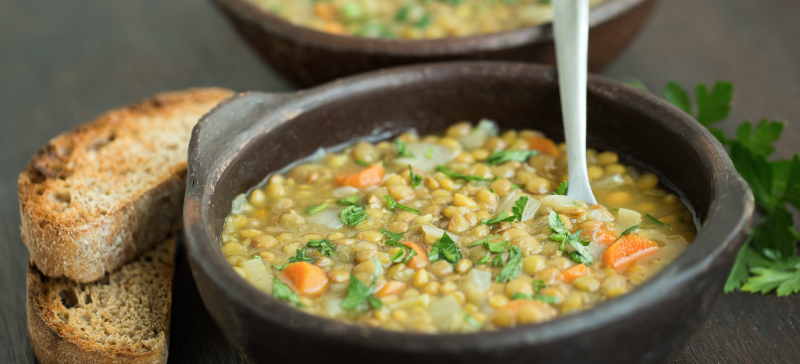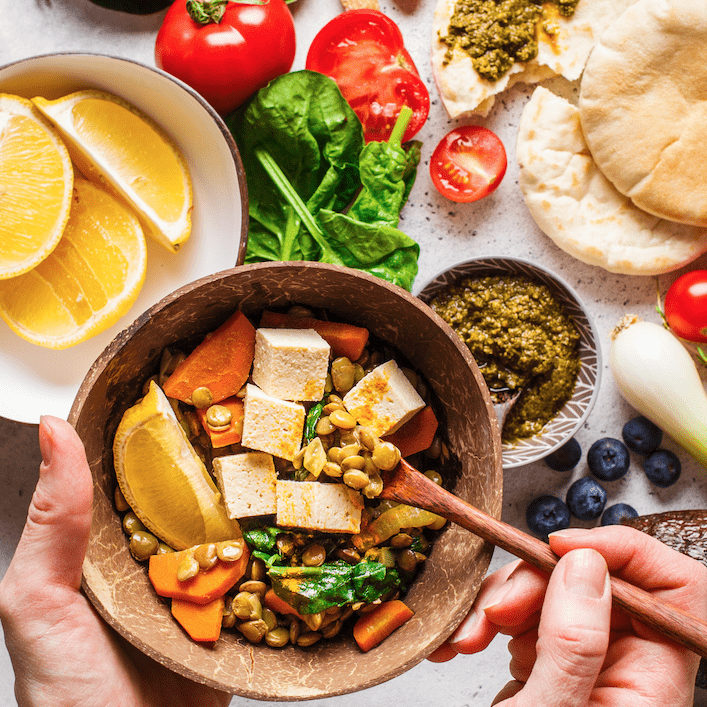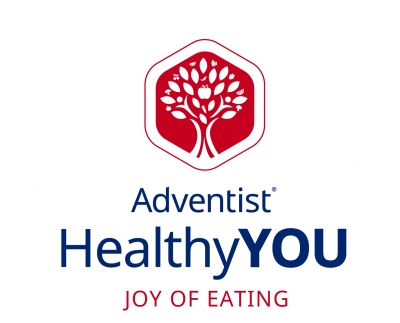Nutrition Considerations for Vegetarians, Part 1
Contributed by Maggie Collins, MPH, RDN, CDCES, DipACLM
A vegetarian diet has been associated with a vast array of health benefits, but what makes it so powerful in preventing, managing, or even reversing chronic diseases is not only the elimination of meat and other animal products, but also the plant-based food choices that are made. In this upcoming webinar we will discuss what are the nutrients of “concern” on a plant-based diet and how to make sure we are not falling short on them to guarantee we are doing the best we can in optimizing our health.
Plant-based diets, including vegetarian and vegan diets have been associated with several health benefits, including the reduced risk of chronic conditions such as diabetes, cardiovascular disease, several types of cancer, obesity, as well as increased longevity [1-4]. More recently, a plant-based diet has even been associated with lower odds of a severe infection with COVID-19 when compared to those following this diet [5]. However, as much as a plant-based eating pattern presents numerous advantages, when done improperly it may lead to a reduced intake of some nutrients. This can be easily prevented with an understanding of what are the nutrients that require some attention on a plant-based diet and proper meal planning to guarantee their adequacy.
The Academy of Nutrition and Dietetics (AND) on its position paper on vegetarian diets, cites key nutrients that those following a plant-based diet should take into consideration when planning their meals, which are: protein, zinc, iron, calcium, omega-3, vitamin D, iodine, and vitamin B-12. We will examine three aspects of these nutrients, divided into a two-part series:
- What is their function in the body.
- What is their daily recommended intake.
- What foods are rich in these nutrients.
Protein
Proteins are large molecules involved in the building and repair of tissues and many metabolic activities in the body. Proteins are also used to make hormones, enzymes, antibodies, and can store and transport nutrients in the body.
Proteins are made up of smaller units, called amino acids. There are 20 different types of amino acids that can be combined in different ways to make all the proteins we need. Plant-based foods offer sufficient protein and all the essential amino acids when the diet meets the caloric needs and is composed of a variety of foods [1].
For the recommended daily protein intake and foods that are rick on this nutrient see article The Truth About Protein.
Zinc
Zinc is involved in a variety of reactions in the body and is essential for a healthy immune system, for growth and development, and for proper wound healing. Zinc also contributes to our sense of taste and smell [6].
How Much Zinc Do I Need to Consume Per Day?
Recommended Dietary Allowances (RDAs) for Zinc [7]
| Age | Male | Female | Pregnancy | Lactation |
|---|---|---|---|---|
| Birth to 6 months | 2 mg* | 2 mg* | ||
| 7 – 12 months | 3 mg | 3 mg | ||
| 1 – 3 years | 3 mg | 3 mg | ||
| 4 – 8 years | 5 mg | 5 mg | ||
| 9 – 13 years | 8 mg | 8 mg | ||
| 14 – 18 years | 11 mg | 9 mg | 12 mg | 13 mg |
| 19+ years | 11 mg | 8 mg | 11 mg | 12 mg |
What foods should I eat to get enough zinc on a plant-based diet?
Zinc is a mineral that concentrates more in foods that are also high in protein. Therefore, good plant-based sources of zinc would include beans, lentils, peas, soy products, nuts, seeds, and whole grains.
Zinc Content of Selected Plant-Based Foods
| Food Options | Serving | Zinc Content (mg) |
|---|---|---|
| Baked beans, canned, vegetarian | 1 cup | 5.8 |
| Lentils, cooked | 1 cup | 2.5 |
| Chickpeas, cooked | 1 cup | 2.6 |
| White beans, cooked | 1 cup | 2.5 |
| Regular oats, cooked | 1 cup | 2.3 |
| Pumpking seeds, dried | 1 oz | 2.2 |
| Quinoa, cooked | 1 cup | 2.0 |
| Tofu, firm | 1/4 block | 2.0 |
| Black beans, cooked | 1 cup | 1.9 |
| Cashew nuts, raw or roasted | 1 oz | 1.6 |
| Whole wheat pasta, cooked | 1 cup | 1.6 |
Source: U.S. Department of Agriculture, Agricultural Research Service. FoodData Central, 2019. fdc.nal.usda.gov.
Tips to Enhance Zinc Absorption and Prevent Losses
Zinc absorption from plant-based foods can be enhanced by [8-11]:
- Soaking and sprouting beans, lentils, peas, whole grains, and seeds;
- Roasting nuts and seeds;
- Consuming leavened whole-grain product such as whole wheat or whole grain bread;
- Fermented foods, such as soy yogurt and tempeh;
Substances to avoid include:
- Alcohol, as it decreases intestinal absorption of zinc and increases urinary zinc excretion [12];
- If taking iron supplements, avoid taking it close to the meal time as it will compete with zinc absorption[13].

Iron
Iron is a component of hemoglobin and myoglobin, proteins that distribute oxygen to the tissues and muscles. Iron is also necessary for growth, development, normal cellular functioning, and for the synthesis of some hormones and connective tissue [7]. A recent review study that compiled data from 27 studies, concluded that vegetarians are more likely to have lower iron stores than non-vegetarians. However, the study also comments that this may be an advantage as high iron stores have been linked to the increase risk of type 2 diabetes [14, 15], has been associated with the buildup of atherosclerosis (plaques inside the arteries that contribute to cardiovascular diseases) [16], and with the increased risk for multiple types of cancer [17-19] .
On the other hand, it is important to prevent iron deficiency anemia as it can affect growth and development, cause fatigue, shortness of breath, headaches, and it will prevent your red blood cells from working properly. The best solution to find the right balance and avoid both extremes of iron deficiency and iron excess is to select plant-based iron-rich foods regularly, avoid taking iron-rich supplements without your healthcare provider recommendation, to observe the tips to enhance plant-based iron absorption, and to evaluate iron stores annually or more frequently as needed.
How Much Iron Do I Need to Consume Per Day?
Recommended Dietary Allowances (RDAs) for Iron [7]
| Age | Male | Female | Pregnancy | Lactation |
|---|---|---|---|---|
| Birth to 6 months | 0.27 mg* | 0.27 mg* | ||
| 7 – 12 months | 11 mg | 11 mg | ||
| 1 – 3 years | 7 mg | 7 mg | ||
| 4 – 8 years | 10 mg | 10 mg | ||
| 9 – 13 years | 8 mg | 8 mg | ||
| 14 – 18 years | 11 mg | 15 mg | 27 mg | 10 mg |
| 19-50 years | 8 mg | 18 mg | 27 mg | 9 mg |
| 51+ years | 8 mg | 8 mg |
What plant foods are rich in iron?
Good sources of plant-based iron include pulses (beans, lentils, and peas), green leafy vegetables, nuts, and fortified grain products.
Iron Content of Selected Plant-Based Foods
| Food Options | Serving | Iron Content (mg) |
|---|---|---|
| Lentils, cooked | 1 cup | 6.7 |
| Black beans, cooked | 1 cup | 5.3 |
| Kidney beans, cooked | 1 cup | 5.2 |
| Sesame seeds, roasted | 1 oz | 4.2 |
| Lima beans, cooked | 1 cup | 4.2 |
| Cowpeas, cooked | 1 cup | 3.6 |
| Edamame, cooked | 1 cup | 3.5 |
| Peas, cooked | 1 cup | 2.5 |
| Tomatoes, canned | 1 cup | 3.4 |
| Tofu, raw, firm, prepared with calcium sulfate | ½ cup | 3.3 |
| Spinach, cooked | ½ cup | 3.2 |
| Pumpking seeds, roasted | ¼ cup | 2.4 |
| Sunflower seeds, roasted | ¼ cup | 2.3 |
| Turnip greens, cooked | 1 cup | 2.8 |
| Russet potato, baked (with skin) | 1 medium | 1.8 |
| Butternut squash, cooked | 1 cup | 1.4 |
| Leeks, cooked | 1 leek | 1.4 |
| Almonds, dry roasted | ¼ cup | 1.3 |
| Sweet potato, baked or boiled | 1 large | 1.4 |
Source: U.S. Department of Agriculture, Agricultural Research Service. FoodData Central, 2019. fdc.nal.usda.gov.
Tips to Enhance Iron Absorption and Prevent Losses
Iron from plant sources (non-heme iron) has a lower rate of absorption than iron from animal sources (heme iron). The absorption of iron from plants sources is enhanced by:
- Vitamin C rich foods, such as: oranges, bell peppers, peaches, strawberries, kiwi, pineapple;
- Fruits in general;
- Foods rich in carotenoids: yellow and orange fruits and vegetables, and green leafy vegetables, such as carrots, spinach, lettuce, tomatoes, sweet potatoes, broccoli, cantaloupe, and winter squash;
It is also important to avoid substances that can bind to iron and reduce its absorption, especially when consumed in the same meal the iron-rich foods are consumed or up to 1 hour after that meal. Those substances are found in:
- Coffee and other caffeinated products [20]
- Calcium supplements. If you need to take them, talk to your healthcare provider to select a calcium citrate formula which can be taken without food so you can plan on taking it away from your meals [21].

Calcium
Calcium is the most abundant mineral in the body. Most of the calcium present in our bodies is stored in the bones and teeth. A small amount of calcium is also required for muscle function, vascular contraction & vasodilation, nerve transmission, and hormonal secretion [22].
How Much Calcium Do I Need to Consume Per Day?
Recommended Dietary Allowances (RDAs) for Calcium [22]
| Age | Male | Female | Pregnancy | Lactation |
|---|---|---|---|---|
| 0 – 6 months* | 200 mg | 200 mg | ||
| 7 – 12 months* | 260 mg | 260 mg | ||
| 1 – 3 years | 700 mg | 700 mg | ||
| 4 – 8 years | 1,000 mg | 1,000 mg | ||
| 9 – 13 years | 1,300 mg | 1,300 mg | ||
| 14 – 18 years | 1,300 mg | 1,300 mg | 1,300 mg | 1,300 mg |
| 19-50 years | 1,000 mg | 1,000 mg | 1,000 mg | 1,000 mg |
| 51 – 70 years | 1,000 mg | 1,200 mg | ||
| 71+ years | 1,200 mg | 1,200 mg |
* Adequate Intake (AI)
What plant foods are rich in Calcium?
When it comes to plant-based calcium-rich foods it is important to consider not only the amount of calcium present in that food but also their bioavailability. In other words, how much of that calcium actually gets absorbed to become effective for its biological functions in the body.
Top Plant-Based Calcium Sources [23] : Cruciferous vegetables have the highest bioavailability of calcium (≥ 50% absorption). Foods from this group include: bok choy, broccoli, Brussels sprouts, cabbage, cauliflower, collard greens, turnip greens, watercress.
Moderate Plant-Based Calcium Sources [23-25]: The calcium-fortified foods such as soy milk, almond milk, cashew milk, coconut milk, hemp milk, tofu and others have an absorption rate similar to dairy (~ 30%).
White beans, pinto beans, almonds, sesame seed, sweet potatoes, tahini, figs, and oranges, have a slightly lower bioavailability (~ 20% absorption).
Poor Plant-Based Calcium Sources [1, 23]: Some vegetables are rich in calcium, but the calcium is poorly absorbed (≤ 5% absorption). Examples are: spinach, rhubarb, beet greens, and Swiss chard. It doesn’t mean we should not consume these vegetables as they are rich sources of other nutrients, but they should not be the focus for calcium adequacy.
Calcium Content of Selected Plant-Based Foods
| Food Options | Serving | Calcium Content (mg) |
|---|---|---|
| Tofu, raw, firm, prepared with calcium sulfate* | ½ cup | 861 |
| Plant-based milk substitutes, fortified with calcium* | 1 cup | ~ 300-450 |
| Collard greens, cooked | 1 cup | 268 |
| Turnip greens, cooked | 1 cup | 249 |
| Cowpeas, cooked | 1 cup | 211 |
| Kale, cooked | 1 cup | 177 |
| White beans, cooked | 1 cup | 161 |
| Almond butter | 2 Tbsp | 112 |
| Edamame, cooked | 1 cup | 98 |
| Chickpeas, cooked | 1 cup | 80 |
| Pinto beans, cooked | 1 cup | 79 |
| Sweet potato, baked or boiled | 1 large | 68 |
| Butternut squash, boiled or baked | 1 cup | 60 |
| Almonds | ¼ cup | 76 |
| Okra, cooked | ½ cup | 62 |
| Broccoli, cooked | 1 cup | 62 |
| Figs, dried | 5 units | 68 |
| Orange | 1 fruit | 61 |
Source: U.S. Department of Agriculture, Agricultural Research Service. FoodData Central, 2019. fdc.nal.usda.gov.
* Calcium content of calcium fortified products will vary by brand. Refer to the nutrition facts label.
Tips to Enhance Calcium Absorption and Prevent Losses
Preventing calcium losses is as important as the adequate intake of calcium. It is estimated that urinary calcium losses account for 50% of the variability in calcium stores [26].
Certain substances can increase calcium losses in the urine or reduce bone formation, so it is important to avoid them:
- Excess dietary salt [27]. Aim to keep your sodium intake at 2,300mg a day or less. That’s equivalent to one teaspoon of table salt.
- Excess protein [28]. A diet high in protein (more likely to happen when consuming meat regularly) contributes to increased urinary calcium losses.
- Tobacco
- Alcohol
Summary
The health benefits of plant-based diets keep unfolding, reassuring our confidence that God’s original diet (Genesis 1:29) continues to be the ideal for human kind. However, it is important to adopt this eating pattern responsibly to guarantee the adequacy of all the nutrients. The idea is not to stress about it and spend your day calculating if you are meeting your nutrient requirements, but you can apply some simple rules to help guide your choices for optimal health:
- Eat enough foods to maintain a healthy weight (consult a BMI chart for guidance on the healthy weight range for your height);
- As much as possible, eat a variety of foods throughout the day, throughout the week, throughout the month, and throughout the year (favor what is in season to make your choices more affordable);
- Avoid substances that can reduce the absorption of nutrients, such as caffeine, tobacco, and alcohol.
- Inform your healthcare provider of your dietary choices so they know which laboratory values to order annually or more often as needed, and discuss the need for any supplementation.
God has furnished man with abundant means for the gratification of an unperverted appetite. He has spread before him the products of the earth—a bountiful variety of food that is palatable to the taste and nutritious to the system.
Counsels on Health, p.114.2

References
- Melina, V., W. Craig, and S. Levin, Position of the Academy of Nutrition and Dietetics: Vegetarian Diets. J Acad Nutr Diet, 2016. 116(12): p. 1970-1980.
- Fraser, G.E. and D.J. Shavlik, Ten Years of Life: Is It a Matter of Choice? Archives of Internal Medicine, 2001. 161(13): p. 1645-1652.
- Tantamango-Bartley, Y., et al., Vegetarian diets and the incidence of cancer in a low-risk population. Cancer epidemiology, biomarkers & prevention : a publication of the American Association for Cancer Research, cosponsored by the American Society of Preventive Oncology, 2013. 22(2): p. 286-294.
- Tonstad, S., et al., Type of vegetarian diet, body weight, and prevalence of type 2 diabetes. Diabetes Care, 2009. 32(5): p. 791-6.
- Kim, H., et al., Plant-based diets, pescatarian diets and COVID-19 severity: a population-based case-control study in six countries. BMJ Nutr Prev Health, 2021. 4(1): p. 257-266.
- (ODS);, O.o.D.S. Zinc. Fact Sheet for Health Professionals. March 26, 2021; Available from: https://ods.od.nih.gov/factsheets/Zinc-HealthProfessional/.
- Institute of Medicine Panel on, M., in Dietary Reference Intakes for Vitamin A, Vitamin K, Arsenic, Boron, Chromium, Copper, Iodine, Iron, Manganese, Molybdenum, Nickel, Silicon, Vanadium, and Zinc. 2001, National Academies Press (US)Copyright 2001 by the National Academy of Sciences. All rights reserved.: Washington (DC).
- Agnoli, C., et al., Position paper on vegetarian diets from the working group of the Italian Society of Human Nutrition. Nutr Metab Cardiovasc Dis, 2017. 27(12): p. 1037-1052.
- Lönnerdal, B., Dietary factors influencing zinc absorption. J Nutr, 2000. 130(5S Suppl): p. 1378s-83s.
- Donangelo, C.M., et al., Supplemental zinc lowers measures of iron status in young women with low iron reserves. J Nutr, 2002. 132(7): p. 1860-4.
- Gibson, R.S., A.L. Heath, and E.A. Szymlek-Gay, Is iron and zinc nutrition a concern for vegetarian infants and young children in industrialized countries? Am J Clin Nutr, 2014. 100 Suppl 1: p. 459s-68s.
- Skalny, A.V., et al., Zinc deficiency as a mediator of toxic effects of alcohol abuse. Eur J Nutr, 2018. 57(7): p. 2313-2322.
- Donangelo, C.M., et al., Supplemental Zinc Lowers Measures of Iron Status in Young Women with Low Iron Reserves. The Journal of Nutrition, 2002. 132(7): p. 1860-1864.
- Haider, L.M., et al., The effect of vegetarian diets on iron status in adults: A systematic review and meta-analysis. Crit Rev Food Sci Nutr, 2018. 58(8): p. 1359-1374.
- Park, S.K., et al., Association of serum ferritin and the development of metabolic syndrome in middle-aged Korean men: a 5-year follow-up study. Diabetes Care, 2012. 35(12): p. 2521-6.
- Naito, Y., T. Masuyama, and M. Ishihara, Iron and cardiovascular diseases. J Cardiol, 2021. 77(2): p. 160-165.
- Sasso, A. and G. Latella, Role of Heme Iron in the Association Between Red Meat Consumption and Colorectal Cancer. Nutr Cancer, 2018. 70(8): p. 1173-1183.
- Cross, A.J., J.R. Pollock, and S.A. Bingham, Haem, not protein or inorganic iron, is responsible for endogenous intestinal N-nitrosation arising from red meat. Cancer Res, 2003. 63(10): p. 2358-60.
- Chen, Y., et al., Iron metabolism and its contribution to cancer (Review). Int J Oncol, 2019. 54(4): p. 1143-1154.
- Morck, T.A., S.R. Lynch, and J.D. Cook, Inhibition of food iron absorption by coffee. Am J Clin Nutr, 1983. 37(3): p. 416-20.
- Palermo, A., et al., Calcium citrate: from biochemistry and physiology to clinical applications. Rev Endocr Metab Disord, 2019. 20(3): p. 353-364.
- Institute of Medicine Committee to Review Dietary Reference Intakes for Vitamin, D. and Calcium, The National Academies Collection: Reports funded by National Institutes of Health, in Dietary Reference Intakes for Calcium and Vitamin D, A.C. Ross, et al., Editors. 2011, National Academies Press (US) Copyright © 2011, National Academy of Sciences.: Washington (DC).
- Whitney., S.R.R.K.P.E., Understanding Normal and Clinical Nutrition. 2021, Cengage Learning.
- Weaver, C.M., W.R. Proulx, and R. Heaney, Choices for achieving adequate dietary calcium with a vegetarian diet. Am J Clin Nutr, 1999. 70(3 Suppl): p. 543s-548s.
- Zhao, Y., B.R. Martin, and C.M. Weaver, Calcium Bioavailability of Calcium Carbonate Fortified Soymilk Is Equivalent to Cow’s Milk in Young Women. The Journal of Nutrition, 2005. 135(10): p. 2379-2382.
- NIH Consensus conference. Optimal calcium intake. NIH Consensus Development Panel on Optimal Calcium Intake. Jama, 1994. 272(24): p. 1942-8.
- Nordin, B.E., et al., The nature and significance of the relationship between urinary sodium and urinary calcium in women. J Nutr, 1993. 123(9): p. 1615-22.
- Barzel, U.S. and L.K. Massey, Excess Dietary Protein Can Adversely Affect Bone. The Journal of Nutrition, 1998. 128(6): p. 1051-1053.


[…] View Part 1 of this series. […]
[…] Zinc – research shows that individuals with depression present lower levels of zinc [51, 52], and zinc supplements may have an antidepressant-like and mood-enhancing capacity of zinc supplements effect both as a stand-alone treatment as well as adjunct to conventional drug therapies [53, 54]. One study demonstrated that 25 mg of zinc supplement once a day was able to significantly improve depressive symptoms in patients treated with tricyclic antidepressants and selective serotonin reuptake inhibitors when compared to a placebo, with the caveat that the effects were not noticeable until six weeks into the experiment [55]. For information on how much zinc we need per day to maintain adequate levels and good plant-based food sources, refer to the article Nutrition Considerations for Vegetarians, Part 1. […]